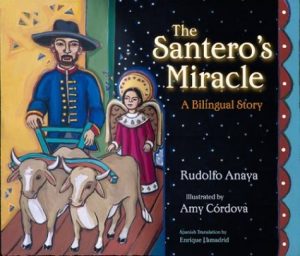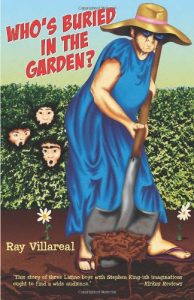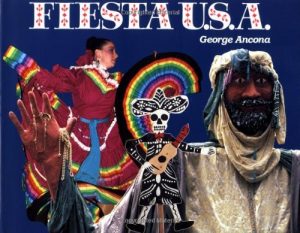 There is another desert party in the works in this spicy companion book to Mañana, Iguana. This time it is Snake’s birthday, and Iguana, Tortoise, and Rabbit are shopping for birthday gifts to bring to his fiesta. But what presents should they buy for Snake? In a sneaky twist, Rabbit convinces them to buy gifts that aren’t for Snake at all—but for him! With a clever text, a spattering of Spanish vocabulary. and lively illustrations, this author-illustrator team presents quite the fiesta fiasco. Glossary included.
There is another desert party in the works in this spicy companion book to Mañana, Iguana. This time it is Snake’s birthday, and Iguana, Tortoise, and Rabbit are shopping for birthday gifts to bring to his fiesta. But what presents should they buy for Snake? In a sneaky twist, Rabbit convinces them to buy gifts that aren’t for Snake at all—but for him! With a clever text, a spattering of Spanish vocabulary. and lively illustrations, this author-illustrator team presents quite the fiesta fiasco. Glossary included.
Southwest
Juan And The Jackalope: A Children’s Book In Verse

When Rosita, the loveliest gal in the Pecos River Valley, offers her delicious rhubarb pie as first prize for the Great Grasshopper Race, a thousand love-struck vaqueros line up for the competition. Of course everyone believes that the legendary cowboy Pecos Bill, riding his giant grasshopper, Hoppy, is a shoo-in for the grand prize. Sure enough, Bill and Hoppy give an impressive performance, crisscrossing the Southwest in a raucous ride. But young Juan, who is hopelessly in love with Rosita, astonishes them all when he and Jack the Jackalope take a miraculous ride around the world and across the Milky Way. The daring pair return, covered in stardust, to claim the beautiful Rosita and her delicious pie. Set in New Mexico, Anaya’s fanciful story, coupled with Amy Cordova’s vivid illustrations, brings the tradition of Southwestern tall tales to a new generation of young readers.
We Won’t Back Down: Severita Lara’s Rise From Student Leader To Mayor (Hispanic Civil Rights)

An enlightening biography for young adults of a little-known female activist in the Hispanic Civil Rights Movement On December 9, 1969, change was in the air. The small town of Crystal City, Texas would never be the same. After weeks of petitioning for a hearing with the Crystal City school board, students of Crystal City High and their parents descended on the superintendent’s office. The students had been threatened with suspension and even physical violence. Powerful members of the community had insisted they would fire the parents of students if they went in front of the school board, and still, they came. Finally, the school board removed the chairs in the gallery, and the parents and students stood until members of the school board fled to avoid the confrontation. As the students and their parents stood in front of the building, a cry rose from the crowd. “Walk out. Walk out.” So began the Crystal City High student walk out. At the center of the fervor was Severita Lara. Called la cabezuda, or stubborn girl, by her mother, Lara bore the mark of a leader from an early age. She was not afraid to stand up to anyone: girls or boys, teachers or superintendents. She always followed her father’s advice, “If you know it’s right, do it.” José Angel Gutiérrez, the famous civil rights leader, chronicle’s Lara’s ascent from a willful child to the mayor of Crystal City. From her father’s doting support to her mother’s steel-rod discipline, Gutiérrez offers a detailed portrait of the early family life of the woman whose continuing struggle against segregation and discrimination began while she was still a high school student in Crystal City. He also follows her attempts as a single mother to achieve her dream of being a doctor and providing for her sons. This is the story of la cabezuda, Severita Lara, who has made an indelible imprint on American history.
The Santero’s Miracle: A Bilingual Story
 In this bilingual story of faith, Don Jacobo has a dream that, in the end, is a reminder that miracles do happen. Jacobo is teaching his visiting grandson Andrés how to become a santero. Christmas is coming, snow is falling in the village, and the two are working on a carving of San Isidro, the patron saint of farmers. The half-finished carving stands in the living room beside the two oxen and the angel that don Jacobo carved earlier in the month. The snow-covered mountains are beautiful, but the road to the village is impassable. Andrés’s parents will not be able to get to the house for the holiday, and Jacobo’s neighbor Leopoldo is desperately ill but cannot get to the hospital. Then comes Jacobo’s dream; San Isidro is plowing with the two oxen and the angel is helping. \”But we don’t plow ’til April\” don Jacobo muses upon awakening. \”What does it mean?\” The night had been bitterly cold and don Jacobo must bundle up to go to the barn to feed his cows and chickens. As he steps outside, he can hardly believe his eyes. The snow-packed road is clear. Rudolfo Anaya’s story of the power of faith, hope, and love will be enjoyed by readers of all ages.
In this bilingual story of faith, Don Jacobo has a dream that, in the end, is a reminder that miracles do happen. Jacobo is teaching his visiting grandson Andrés how to become a santero. Christmas is coming, snow is falling in the village, and the two are working on a carving of San Isidro, the patron saint of farmers. The half-finished carving stands in the living room beside the two oxen and the angel that don Jacobo carved earlier in the month. The snow-covered mountains are beautiful, but the road to the village is impassable. Andrés’s parents will not be able to get to the house for the holiday, and Jacobo’s neighbor Leopoldo is desperately ill but cannot get to the hospital. Then comes Jacobo’s dream; San Isidro is plowing with the two oxen and the angel is helping. \”But we don’t plow ’til April\” don Jacobo muses upon awakening. \”What does it mean?\” The night had been bitterly cold and don Jacobo must bundle up to go to the barn to feed his cows and chickens. As he steps outside, he can hardly believe his eyes. The snow-packed road is clear. Rudolfo Anaya’s story of the power of faith, hope, and love will be enjoyed by readers of all ages.
Americas Award For Children’s And Young Adult Literature. Commended (Awards)
Fiesta U.S.A.
Juan The Bear And The Water Of Life: La Acequia De Juan Del Oso (Paso Por Aqui Series On The Nuevomexicano Literary Heritage)
 La Acequia del Rito y la Sierra in the Mora Valley is the highest and most famous traditional irrigation system in New Mexico. It carries water up and over a mountain ridge and across a sub-continental divide, from the tributaries of the RÃo Grande to the immense watershed of the Mora, Canadian, Arkansas, and Mississippi Rivers. The names and stories of those who created this acequia to sustain their communities have mostly been lost and replaced by myths and legends. Now, when children ask, some parents attribute the task of moving mountains and changing the course of rivers to Juan del Oso, the stouthearted man whose father was a bear.From the mountains of northern Spain to the Andes in South America, Spanish-speaking people have told ancient legends of Juan del Oso and his friends. In this children’s tale, agriculturalist Juan Estevan Arellano and folklorist Enrique Lamadrid share a unique version of a celebrated story that has been told in northern New Mexico for centuries.Reading level: age 10 years and up
La Acequia del Rito y la Sierra in the Mora Valley is the highest and most famous traditional irrigation system in New Mexico. It carries water up and over a mountain ridge and across a sub-continental divide, from the tributaries of the RÃo Grande to the immense watershed of the Mora, Canadian, Arkansas, and Mississippi Rivers. The names and stories of those who created this acequia to sustain their communities have mostly been lost and replaced by myths and legends. Now, when children ask, some parents attribute the task of moving mountains and changing the course of rivers to Juan del Oso, the stouthearted man whose father was a bear.From the mountains of northern Spain to the Andes in South America, Spanish-speaking people have told ancient legends of Juan del Oso and his friends. In this children’s tale, agriculturalist Juan Estevan Arellano and folklorist Enrique Lamadrid share a unique version of a celebrated story that has been told in northern New Mexico for centuries.Reading level: age 10 years and up
Who’s Buried In The Garden?
 Seventh-grader Joshua knows his best friend Artie Mendoza is a liar. They have been friends since kindergarten, and Artie has told far-fetched stories for years. So when Artie tells Josh that there’s a body buried in Mrs. Foley’s garden, Josh doesn’t believe him at first. But when Josh walks by the Foleys’ house, he sees the mound of earth, about seven feet long and covered with flowers, and has to admit it does look like a grave. Artie insists that Mrs. Foley killed her husband and buried him in the back yard. The Foleys used to fight so loudly that kids walking in the alley behind their house could hear the arguments. Lately, there hasn’t been any sign of Mr. Foley. Still, Josh has his doubts. But Wolf Man, Artie’s other best friend, naively believes everything his friend tells him and encourages Artie’s plan to dig up the body. Josh doesn’t care much for Wolf Man, and if he’s honest with himself, he knows he’s jealous of the friendship between Wolf Man and Artie. Unlike Josh, they watch wrestling on TV, don’t care much about school, and on top of that, speak Spanish fluently, which makes Josh feel left out. While Josh struggles to avoid getting caught up in Artie’s scheme to get famous by digging up the supposed body in Mrs. Foley’s backyard he also tries to cultivate his budding friendship with Lorena, the prettiest girl in the seventh grade, who challenges Josh to see both Artie and Wolf Man in a different light. With other problems sprouting up all around him, Josh can’t help but wonder if there’s really a shovel-wielding criminal living in the neighborhood. Instead of digging up the garden, or grave, shouldn’t they call the police? Young adult author and educator Ray Villareal has written another fast-paced, exciting novel for middle-school students that explores the impact of making poor decisions and the importance of choosing the right friends.
Seventh-grader Joshua knows his best friend Artie Mendoza is a liar. They have been friends since kindergarten, and Artie has told far-fetched stories for years. So when Artie tells Josh that there’s a body buried in Mrs. Foley’s garden, Josh doesn’t believe him at first. But when Josh walks by the Foleys’ house, he sees the mound of earth, about seven feet long and covered with flowers, and has to admit it does look like a grave. Artie insists that Mrs. Foley killed her husband and buried him in the back yard. The Foleys used to fight so loudly that kids walking in the alley behind their house could hear the arguments. Lately, there hasn’t been any sign of Mr. Foley. Still, Josh has his doubts. But Wolf Man, Artie’s other best friend, naively believes everything his friend tells him and encourages Artie’s plan to dig up the body. Josh doesn’t care much for Wolf Man, and if he’s honest with himself, he knows he’s jealous of the friendship between Wolf Man and Artie. Unlike Josh, they watch wrestling on TV, don’t care much about school, and on top of that, speak Spanish fluently, which makes Josh feel left out. While Josh struggles to avoid getting caught up in Artie’s scheme to get famous by digging up the supposed body in Mrs. Foley’s backyard he also tries to cultivate his budding friendship with Lorena, the prettiest girl in the seventh grade, who challenges Josh to see both Artie and Wolf Man in a different light. With other problems sprouting up all around him, Josh can’t help but wonder if there’s really a shovel-wielding criminal living in the neighborhood. Instead of digging up the garden, or grave, shouldn’t they call the police? Young adult author and educator Ray Villareal has written another fast-paced, exciting novel for middle-school students that explores the impact of making poor decisions and the importance of choosing the right friends.
The Smell Of Old Lady Perfume
 Claudia Guadalupe Martinez’s debut novel for young adults is a bittersweet story about death, family, and the resilient emotional strength of the human heart. Chela Gonzalez, the book’s narrator, is a nerd and a soccer player who can barely contain her excitement about starting the sixth grade. But nothing is as she imagined-her best friend turns on her to join the popular girls and they all act like Chela doesn’t exist. She buries herself in schoolwork and in the warm comfort of her family. To Chela, her family is like a solar system, with her father the sun and her mother, brothers, and sister like planets rotating all around him. It’s a small world, but it’s the only one she fits in.But that universe is threatened when her strong father has a stroke. Chela’s grandmother moves in to help the family. The smell of her old lady perfume invades the house. That smell is worse than Sundays. Sundays were sad, but they went just as sure as they came. Death was a whole other thing, and Chela doesn’t understand that’s what everyone is waiting for. In her grief and worry, Chela begins to discover herself and find her own strength.Claudia Guadalupe Martinez was born in El Paso, Texas. She learned that letters form words from reading the subtitles of old Westerns for her father. She went on to graduate from college and moved to Chicago to become one of the city’s youngest nonprofit executives.
Claudia Guadalupe Martinez’s debut novel for young adults is a bittersweet story about death, family, and the resilient emotional strength of the human heart. Chela Gonzalez, the book’s narrator, is a nerd and a soccer player who can barely contain her excitement about starting the sixth grade. But nothing is as she imagined-her best friend turns on her to join the popular girls and they all act like Chela doesn’t exist. She buries herself in schoolwork and in the warm comfort of her family. To Chela, her family is like a solar system, with her father the sun and her mother, brothers, and sister like planets rotating all around him. It’s a small world, but it’s the only one she fits in.But that universe is threatened when her strong father has a stroke. Chela’s grandmother moves in to help the family. The smell of her old lady perfume invades the house. That smell is worse than Sundays. Sundays were sad, but they went just as sure as they came. Death was a whole other thing, and Chela doesn’t understand that’s what everyone is waiting for. In her grief and worry, Chela begins to discover herself and find her own strength.Claudia Guadalupe Martinez was born in El Paso, Texas. She learned that letters form words from reading the subtitles of old Westerns for her father. She went on to graduate from college and moved to Chicago to become one of the city’s youngest nonprofit executives.
Abuelos
 The tradition of los abuelos comes from northern New Mexico. In the cold months of midwinter, village men disappear to disguise themselves as scary old men and then descend on the children, teasing them and asking if they’ve been good. The abuelos encourage the little ones to dance and sing around huge bonfires. Afterwards, everyone enjoys cookies and empanadas. In this charming book, young Ray and Amelia move to a new village and experience the fright and fun of los abuelos for the first time. Amelia Lau Carling researched the region for her vibrant artwork, and author Pat Mora’s lively text captures the appeal of an old-world celebration now being revived.
The tradition of los abuelos comes from northern New Mexico. In the cold months of midwinter, village men disappear to disguise themselves as scary old men and then descend on the children, teasing them and asking if they’ve been good. The abuelos encourage the little ones to dance and sing around huge bonfires. Afterwards, everyone enjoys cookies and empanadas. In this charming book, young Ray and Amelia move to a new village and experience the fright and fun of los abuelos for the first time. Amelia Lau Carling researched the region for her vibrant artwork, and author Pat Mora’s lively text captures the appeal of an old-world celebration now being revived.

